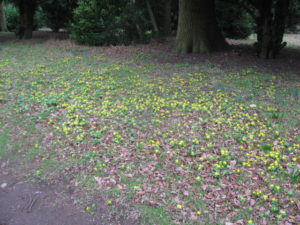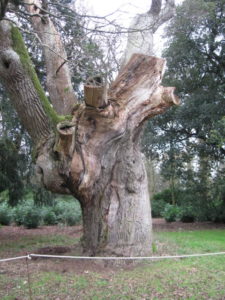One of the Herveys who lived at Ickworth called it a magnificent folly but it was also a delusional re-creation of the environment. Accept the huge biscuit barrel of the Rotunda as an outrageous piece of Wedgwood – the frieze of Trojan War reliefs were by Wedgwood’s designer Flaxman – and you become as much a pawn in the landscape as the original villagers. They had their homes demolished and rebuilt where the absentee Bishop of Derry couldn’t see them. Surprisingly for one with little interest in the church he kept the local one as a focal point in his view.
The house doesn’t open until March, unless you wish to stay at the hotel occuping the west wing: it allows non-residents to go in for meals or refreshments, but then so does the National Trust restaurant in the east wing. That used to be in the old basement kitchens, and very cosy too until they began re-enactments with visitors as servants. The new restaurant was previously the orangery, and in good weather use can be made of the conservatory or even outside tables. We noticed though that new cane armchairs and sofas occupy the middle space with rows of more formal tables and chairs either side.
Choosing just a coffee and cake we settled into the cane chairs, and could have stayed there for hours. They were playing tracks of 1930s swing bands, from the last period of prosperity in the Hervey family after a wealthy marriage restored the fortune lost on a canal project. Our aim was the garden though, where 100,000 scones’ worth of box hedging has to be restored after blight. Information on the board told me my scone was two centimetres’ worth. With that in mind we started out.
Apart from non-Italian sky the Italianate garden is the obvious choice in winter. Green shrubs don’t suffer dead-heading and their forms are maintained. Ickworth has the oldest surviving example. In a discreet enclosure it has drought resistant planting – coals to Newcastle after recent weather. It is lovely, though, and frames the “temple” summerhouse.
Nearby is the Stumpery, an innovation the gothically-minded Herveys may well have enjoyed. Certainly the insects and squirrels do. In keeping with family traditions there is even a Hell-Fire Club display of hanging bones and a skull. More piratical perhaps are the blocks of basalt from the Giants’ Causeway now surrounded by the stumps. What would the National Trust of Northern Ireland have to say about that, we wondered.
Even an English winter produces some flowers, and this winter has been mild, with plants well in advance of normal. The hellebores were in evidence, and along the Albana Walk were drifts of aconites with just a few snowdrops among them. As the walk proceeded on its two-mile circuit the ratio changed until there were only snowdrops beneath the old trees. Microclimate may be the explanation although it is by no means unusual for aconites and snowdrops to flourish together.
In keeping with the Stumpery idea old trees are not felled on the estate but left as they decline. This creates a “natural” woodland, managed for a different kind of succession to previous landscape trends. Similary the parkland is managed by grazing sheep rather than gang-mowing, and blends into the surrounding arable fields.
It wasn’t exactly strenuous walking although more than just a stroll. Around the gardens and then two miles of woodland in perhaps an hour and a half meant an enjoyable experience with time to look as well as walk. There is a “Trim Trail” with exercise stations: all very well for the young but they could equally go to the gym. We had the landscape, an energising wind, some squally rain, the woods and flowers, birds, squirrels and sheep, just right for after lunch and home before dusk.










